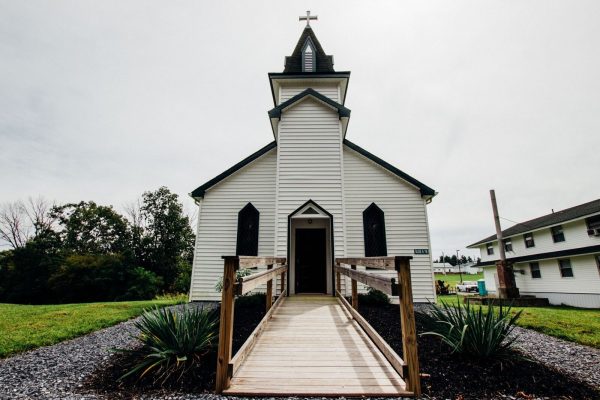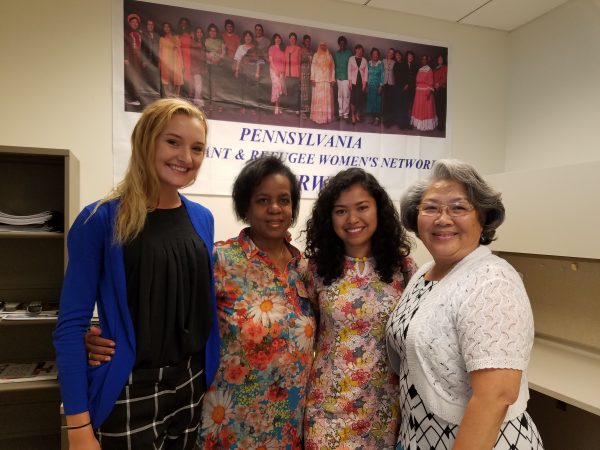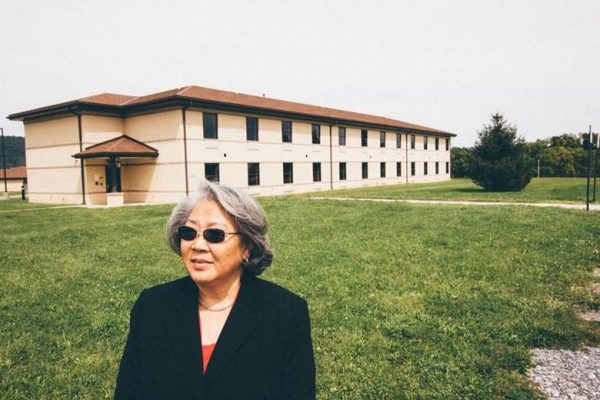
Ho-Thanh Nguyen went back to Fort Indiantown Gap recently. Here, she’s in front of the National Guard training area where her barracks stood in 1975. She and her siblings lived here when they first resettled in the United States after fleeing Vietnam. (Tim Lambert/WITF)
FORT INDIANTOWN GAP – Even after 40 years, Ho-Thanh Nguyen remembers.
“That’s an old, old, old building right there. All wood,” she says as we drive past a structure that is, like many on the military base, non-descript.
Then, in a hushed tone:
“I think that’s the chapel,” she says. “Yeah, that’s it, the one I was telling you about.”
Nguyen, now 62, spent time in the tiny church nearly every day of her stay at the base in 1975. She was among more than 22,000 refugees resettled through Fort Indiantown Gap in the wake of the Vietnam War.
“We didn’t have anything else to do,” she explains, at first.
But it’s more than that: she’s devoted to her Catholic faith, and says praying rosaries brings her a meditative comfort.
The chapel is one of few structures remaining from back then. National Guard training facilities stand in place of the barracks she lived in, and the mess hall she frequented isn’t here anymore either.
“That’s a C-130, right? Yep, I remember,” she says laughing. “From the Philippines, to Guam Island. We sit on the floor of the C-130 and with the seat belt across us like cargo. We just held on.”
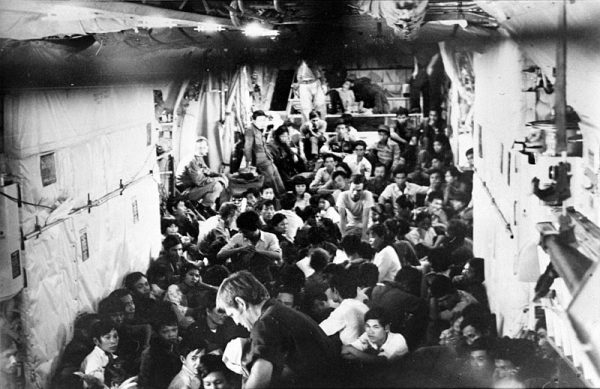
South Vietnamese refugees in the cargo compartment of a C-130 in April 1975 (Photo Source: Australian War Memorial)
It was her first time flying.
Nguyen and her five siblings fled South Vietnam during the final days of the war.
They’d reached the Philippines by boat, enduring a weeklong journey across the South China Sea.
Nguyen, then a law student, was in charge because she was the oldest and their parents had stayed behind with their grandparents.
She was 20 years old.
“Everybody had a handful of rice and a glass of water. The rice, they mixed salt in there for us to eat. And when the storm came, we took plastic bag to hold the water and that’s what we used to drink and … I’m concerned because my brother my little brother was starving,” she says. “[Everyone] was starving but especially the little one.”
The ordeal left Nguyen with post-traumatic stress disorder from this.
“If you go to my car you’ll see – water, crackers, cookies,” she says. “And I have a sleeping bag, too, because I don’t know where I will be the next where my next meal is. Even I know that I have freedom here, I have everything that I have here, I never know what could happen.”
It seems like challenges never cease for Nguyen and tens of millions of other refugees: finding work, learning a new language, trying to get a better job, facing discrimination.
LISTEN TO THE STORY
Nguyen says resettlement’s easier now in at least one way:
“With the technology of the news and media and the Internet, they know more information ahead of time. In 1975, we didn’t have that.”
But Nguyen thinks that, on the balance, it’s harder now for refugees. The realization prompted her to start the Pennsylvania Immigrant and Refugee Women’s Network, or PAIRWN, 17 years ago.
There were just a few resettlement agencies in the 1970s, and virtually no infrastructure compared to what’s in place today.
Regret over how the United States handled refugee resettlement after World War II seemed to drive policy in the late 1970s, according to American University history professor Alan Kraut.
“There were 11 million displaced persons, and the United States ended up taking in a total of only about 400,000. So we were not very generous in that period,” says Kraut, who focuses on immigration, American medicine and public health. “We were a bit more generous following the Vietnam War.”
The resettlement process took mere months back then, with relatively minimal paperwork completed on U.S. soil.
But within five years, Congress was passing the Refugee Act of 1980.
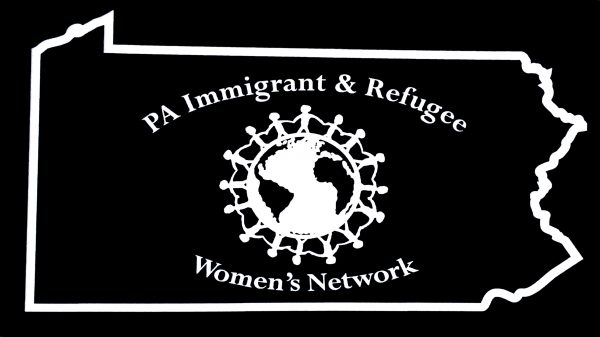
Amid concerns about security and overwhelming local schools and health and social service agencies, the law established a legal definition for a refugee as someone who “has a well-founded fear of persecution,” which mirrors the United Nations’ language, Kraut says.
Interviews, paperwork, background checks – the standards and procedure grew more stringent over time.
And the law established an annual refugee admissions ceiling, limited refugee admissions. That has fluctuated over time, as this Migration Policy Institute analysis shows, but never eclipsed prior levels.
“There are always exceptions in a crisis where more of one particular group or another is admitted,” Kraut says. “But remember during this period the United States is admitting legally over a million people a year as immigrants. In addition to that, there’s increasing concern about the number of undocumented migrants coming to the United States. So all of this is in the in the mix in these discussions.”
Kraut says other issues brought up by policymakers included effects on local agencies and resources, and how to prevent overloading them.
In the 70s, refugees also were processed through just four military bases – including the Gap – and just a few outside resettlement agencies were involved.
Now nine national organizations resettle refugees through a network of local offices in countless cities across the country.
In Nguyen’s view, this particular change is critical:
“The pockets of refugees come in, but they’re so small, they have a hard time connecting with [each] other,” she says. “It’s hard to navigate.”
Then there’s federal funding.
Resettlement agencies are getting less money than anticipated to support refugees during their first 90 days in the U.S. because the admissions limit was lowered mid-way through the federal fiscal year, after President Trump took office.
It seems like it shouldn’t have an impact, but nonprofits’ margins are supposed to be thin by legal definition. So if a major revenue source is half the amount expected, there’s an impact. The shortfall might mean staff cuts, or less of a cushion to help cover costs while waiting for other funding sources to come through.
Agencies offices in Allentown, Erie, Philadelphia, Lancaster and Harrisburg reported at least a couple layoffs. Some are scaling back to basic services: job placement and housing.
Charlotte Fry, who heads the state Office of Refugee Resettlement, says she’s hearing the same.
“With fewer arrivals and fewer dollars in place for the reception and placement program, the money that is received, it needs to be targeted toward employment services and as well as, you know, ensuring that refugees have access to English language classes. But beyond that, money that used to flow … much more openly for case management, that can’t be a focus,” Fry said. “You simply can’t support it, financially.”
Some resettlement agencies are turning to churches and other partners for volunteers to train for things like enrolling children in school.
And it seems more refugees will probably utilize non-profits like PAIRWN for referrals to transportation, mental health and other services, educational seminars, extra English language instruction, etc.
And group therapy, of sorts.
“We don’t call it group therapy,” Nguyen says. “It’s a taboo that you’re going to see a psychiatrist or psychologist. So it’s called a story circle.”
Story circles aren’t unique to PAIRWN.
But the nonprofit has been training other providers on how to run story circles recently, according to Fry, and has been hosting its own events every couple months for years.
It’s a forum free of the stigma that many of these women might fear for seeking formal treatment, Nguyen says.
And it’s in their language.
Nguyen says she’s attempted to address her PTSD with a psychologist, but the language barrier resulted in truncated treatment that wasn’t much help.
“If you can’t speak the language your own language to express yourself it doesn’t do any good,” she says. “That’s why we have a story circle, and the people come and they can talk about anything that they want to.”
Check out more audio and photos of Nguyen at this LINK. You can find stories of others profiled in WITF’s Vietnam War series HERE.

